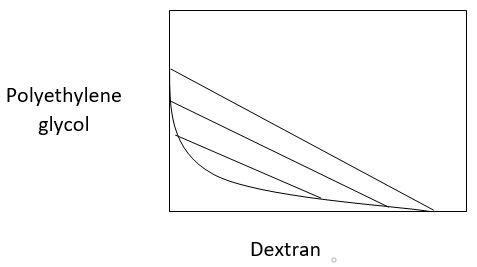This set of Bioseparation Processes Multiple Choice Questions & Answers (MCQs) focuses on “Aqueous Two-Phase Extraction”.
1. What is the significance of the given phase diagram?

a) Aqueous two phase extraction system
b) Single phase extraction
c) Precipitation
d) Concurrent extraction
View Answer
Explanation: The phase diagram explains the aqueous two phase extraction system for different concentrations of polyethylene glycol (PEG) and dextran. There are two liquid phases in the phase diagram and the tie lines connect the compositions of the phases which are in equilibrium state.
2. The PEG rich phase is less dense than either the dextran-rich phase and thus is lighter or on top phase.
a) False
b) True
View Answer
Explanation: The phase enriched in PEG will not contain any dextran and is less dense therefore moves on the top phase. The typical concentration of PEF-dextran is 10% PEG and 15% dextran (W/W). It helps in removal of contaminating by-products and is non-denaturing techniques of separation.
3. How can you extract the compounds having acidic functional groups from the solvent?
a) Controlling the temperature
b) Controlling the solubility
c) Controlling the pH
d) Controlling the volume
View Answer
Explanation: The fermentation broth which involve the presence of uncharged products having acidic functional group can have proton-transfer reactions which leads in charge species like \(RNH_3^+\) and RCOO–, the extraction of solvent is carried out by the means of control of pH.
4. When a solvent is extracted what will be the number of stages of transfer in order to obtain the purified form of phase ratio resulting into 99% pure solute V/V ratio is 0.05 and the separation factors are 1.2, 1.5, 2.0 and 2.5?
a) 80, 65, 49, 40
b) 65, 40, 49, 80
c) 40, 80, 65, 49
d) 49, 40, 80, 65
View Answer
Explanation: The number of stages can be obtained by n = 1 + \(\frac{log(\theta_n)}{log(1 -\frac{ VK_D}{1 + VK_D})}\) where, KD is 1.2 then number of stages 80. When, KD is 1.5 then number of stages 65, When, KD is 2.0 then number of stages 49 and when KD is 2.5 then number of stages 40.
5. What will be the thickness of double layer when the electronic charge is 0.2 C, boltzman constant is 2, bulk concentration in the ionic species is 2.5 g/mol, Debye-Huckel constant is 5, valency of the electrolyte is 2 and the dielectric constant is 0.5 F/m?
a) 0.005
b) 0.105
c) 1.005
d) 1.050
View Answer
Explanation: \(\frac{1}{K} = (\frac{\epsilon kT}{8\pi e^2 n_0 z^2})^{\frac{1}{2}}\) So, the thickness is \(\frac{1}{5} = (\frac{0.5 × 2 × T}{8\pi × 0.2^2 × 2.5 × 2^2})^{\frac{1}{2}}\) = 1.005m.
∴ The thickness of double layer is 1.005m.
6. The zeta potential can be measured directly using the experimental value.
a) True
b) False
View Answer
Explanation: The zeta potential cannot be measured directly, it needs to be calculated on the basis of theories for a double layer electric current which depends on the electrophoresis attractions, the stokes friction, electrophoresis retardation and the effects of relaxation time.
7. What are the two different types of aqueous two phase extraction systems?
a) Salt-polymer, Polymer-salt
b) Polymer- acid, acid-polymer
c) Polymer-base, polymer-polymer
d) Polymer-polymer, polymer salt
View Answer
Explanation: The aqueous two phase extraction system is a special case of liquid-liquid extraction which involves the transfer of solute from one aqueous phase to another. The two different types of aqueous two phase extraction systems are polymer-polymer two-phase system and polymer-salt two-phase system.
8. What is the example of polymer-polymer two phase systems?
a) PEG and PEG
b) Dextran and Dextran
c) PEG and Dextran
d) Dextran and acid
View Answer
Explanation: A polymer-polymer two phase system is obtained by mixing Dextran and PEG at a certain composition. By adding specific amounts of these polymers to an aqueous feed phase, two aqueous phases, one rich in PEG and the other rich in Dextran can be obtained.
9. What is the example of polymer salt two phase systems?
a) Dextran and sodium phosphate
b) Dextran and PEG
c) Sodium phosphate and potassium phosphate
d) Potassium phosphate and sulphuric acid
View Answer
Explanation: Aqueous two-phase systems can be generated using a polymer and a salt such as dextran or PEG and sodium or potassium phosphate. Aqueous two-phase separations take place at certain compositions only. The “binary” phase diagrams which are based on the compositions of the polymer and salt are used for determining the concentrations needed for an extraction process.
10. The extraction of protein in aqueous two-phase extraction process depends on _____________
a) pH, polymer composition
b) molecular weight, pH
c) polymer composition
d) pH, molecular weight, polymer composition
View Answer
Explanation: In aqueous two-phase extraction of proteins, the partition behaviour depends to a great extent on the relative polymer composition and also depends on the solution pH and the molecular weight of the protein.
Sanfoundry Global Education & Learning Series – Bioseparation Processes.
To practice all areas of Bioseparation Processes, here is complete set of 1000+ Multiple Choice Questions and Answers.
If you find a mistake in question / option / answer, kindly take a screenshot and email to [email protected]
